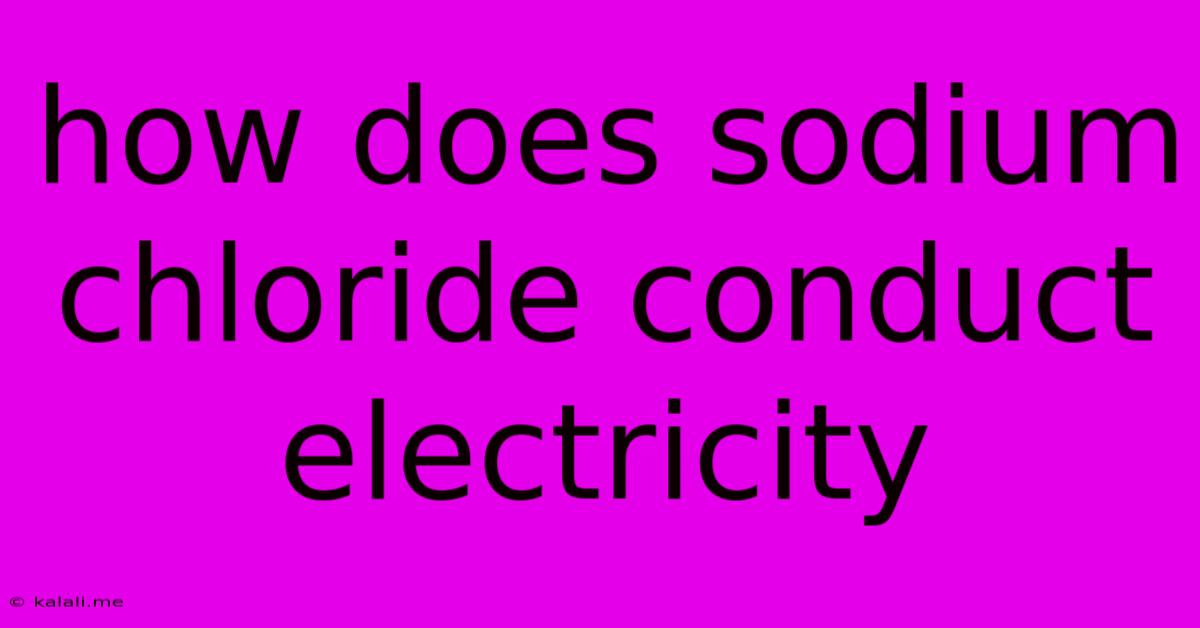How Does Sodium Chloride Conduct Electricity
Kalali
May 21, 2025 · 3 min read

Table of Contents
How Does Sodium Chloride Conduct Electricity? Understanding Ionic Conductivity
Meta Description: Discover how sodium chloride (table salt) conducts electricity. This article explains the process of ionic conductivity, highlighting the role of ions and the conditions necessary for electrical conduction in NaCl.
Sodium chloride, or common table salt, is a crystalline solid that, surprisingly, can conduct electricity – but only under specific conditions. Unlike metals which conduct electricity through the movement of electrons, NaCl conducts through the movement of ions. This process is known as ionic conductivity. This article will delve into the specifics of how this occurs.
The Structure of Sodium Chloride
To understand its electrical conductivity, we need to examine the structure of sodium chloride. NaCl forms a cubic crystal lattice structure. In this structure, sodium (Na⁺) and chloride (Cl⁻) ions are arranged in a regular, repeating pattern. Each positively charged sodium ion is surrounded by six negatively charged chloride ions, and vice versa, held together by strong electrostatic forces of attraction. This strong ionic bonding is responsible for NaCl's high melting point.
Ionic Conductivity: The Key to Electrical Conduction
In its solid state, NaCl does not conduct electricity. The ions are rigidly held in place within the crystal lattice, unable to move freely to carry an electric current. However, when molten (melted) or dissolved in water (forming an aqueous solution), the situation changes dramatically.
-
Molten Sodium Chloride: Heating NaCl to its melting point (801°C) breaks the strong ionic bonds, allowing the Na⁺ and Cl⁻ ions to become mobile. These mobile ions can now move freely, carrying an electric charge when a potential difference (voltage) is applied. The positively charged sodium ions migrate towards the negative electrode (cathode), while the negatively charged chloride ions migrate towards the positive electrode (anode), thus completing the electric circuit.
-
Aqueous Sodium Chloride Solution: When NaCl dissolves in water, the polar water molecules surround and separate the Na⁺ and Cl⁻ ions. This process, known as dissociation, frees the ions from the crystal lattice, allowing them to move independently in the solution. Once again, the application of a voltage causes these mobile ions to migrate towards their respective electrodes, resulting in electrical conductivity. The water molecules themselves don't carry the charge, but they facilitate the movement of the ions.
Factors Affecting Conductivity
The conductivity of molten or aqueous NaCl depends on several factors:
- Temperature: Higher temperatures increase ionic mobility, leading to higher conductivity.
- Concentration: For aqueous solutions, higher concentrations of NaCl result in higher conductivity due to a greater number of charge carriers.
- Presence of impurities: Impurities can affect conductivity, sometimes increasing it and other times decreasing it depending on the nature of the impurity.
In Summary
Sodium chloride conducts electricity not through the flow of electrons, but through the movement of its constituent ions. This ionic conductivity is only possible when the ions are free to move, either in a molten state or when dissolved in a polar solvent like water. Understanding the structure and properties of NaCl provides valuable insight into this important aspect of its behavior.
Latest Posts
Latest Posts
-
How To Get Rid Of Diesel Smell
May 21, 2025
-
How To Change Water Pressure In Shower
May 21, 2025
-
How Long Can Bolognese Stay In The Fridge
May 21, 2025
-
Best Time To Check Engine Oil
May 21, 2025
-
Bin Bash M Bad Interpreter No Such File Or Directory
May 21, 2025
Related Post
Thank you for visiting our website which covers about How Does Sodium Chloride Conduct Electricity . We hope the information provided has been useful to you. Feel free to contact us if you have any questions or need further assistance. See you next time and don't miss to bookmark.